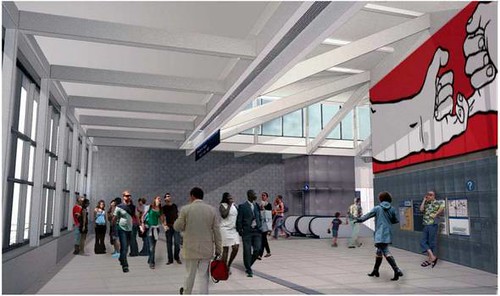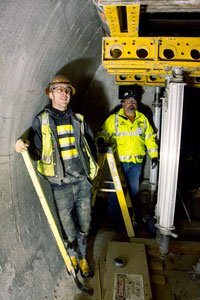
As the community and the City of Seattle shape the development to come above ground around it, Capitol Hill Station is reaching its next construction phase as global construction company Turner readies its innovative method to create the station’s concrete walls and floors.
We told you before that Turner won the $110 million contract by the Sound Transit board to build the station. The company says its unique framing approach will take less time than conventional methods and allow walls on both sides of the station box to be completed together.
Sound Transit says the contractor’s work will begin in March.
Here’s more from Sound Transit about the “innovative formwork,” which is not yet widely used in underground construction:
A collapsible steel truss system will be lowered into the shaft where it will expand like an accordion to create the framework for the station’s thick concrete walls and floors. After the concrete for each section is poured, the forms will be collapsed, moved along a rail system and positioned for the next 40-foot section. This cycle can be repeated every four to five days including the time needed to cure the concrete.
As with any large concrete pour, the temperature of the concrete must be controlled as it cures. To aid this process, Turner will install a PVC piping system within the formwork. Water that re-circulates through the pipes will cool the concrete and help maintain a constant curing temperature.
 Crews working on Cross Passage 17. Photo – Sound Transit
Crews working on Cross Passage 17. Photo – Sound Transit
What is Cross Passage 17?
Cross Passage 17 is one of 21 horizontal tunnels, 18-24 feet long and about 10 feet in diameter, that connect the two University Link tunnels running between downtown Seattle and Husky Stadium. Cross passages provide emergency access as well as entry and exit between tunnels for routine maintenance.Building Cross Passage 17 became very challenging when the contractor encountered more water than originally anticipated. To stabilize the area for mining, it was necessary to remove water from the ground surrounding the tunnel to give crews a safe working environment. For more than six months, generator-powered pumps removed water from soils around the tunnels. Today, Cross Passage 17 is nearly complete and work has turned to finishing the U-Link tunnels, including installing concrete duct banks, walkways, light rail tracks, power and signaling supply lines, tunnel lighting and communications systems.
Construction at a glance (data as of December 2012)
UW
Capitol Hill
Demolition
100%
100%
Station Excavation
100%
100%
Tunnel construction – TBM mining
100%
100%
Tunnel Construction – Cross Passage Excavation and Lining
100%
100%
Station construction
55%
0%
Power Systems & Track
0%
0%
U-Link Overall 61.62%



not seeing the plans or the specific configuration, this sounds like a system that was used in 2005 on an underground rail transit station in NJ.
We used a similar expandable form system to pour the reinforced concrete coffered arches in the Washington, D.C. Metro in 1974-1976. The Gallery Place Station and the Metro Center station were both built using that technology. We poured sections 50 feet at a time. Stations are 80′ wide x 74′ high x 1,000 feet long.
It’s a great technology, but it isn’t new.
Any chance they will do a tunnel walk like they did for the metro tunnel? I’d love to walk from Broadway to the University via the tunnel.
From what I’ve seen through the windows on John St, it sure looks to me like this work has already begun.